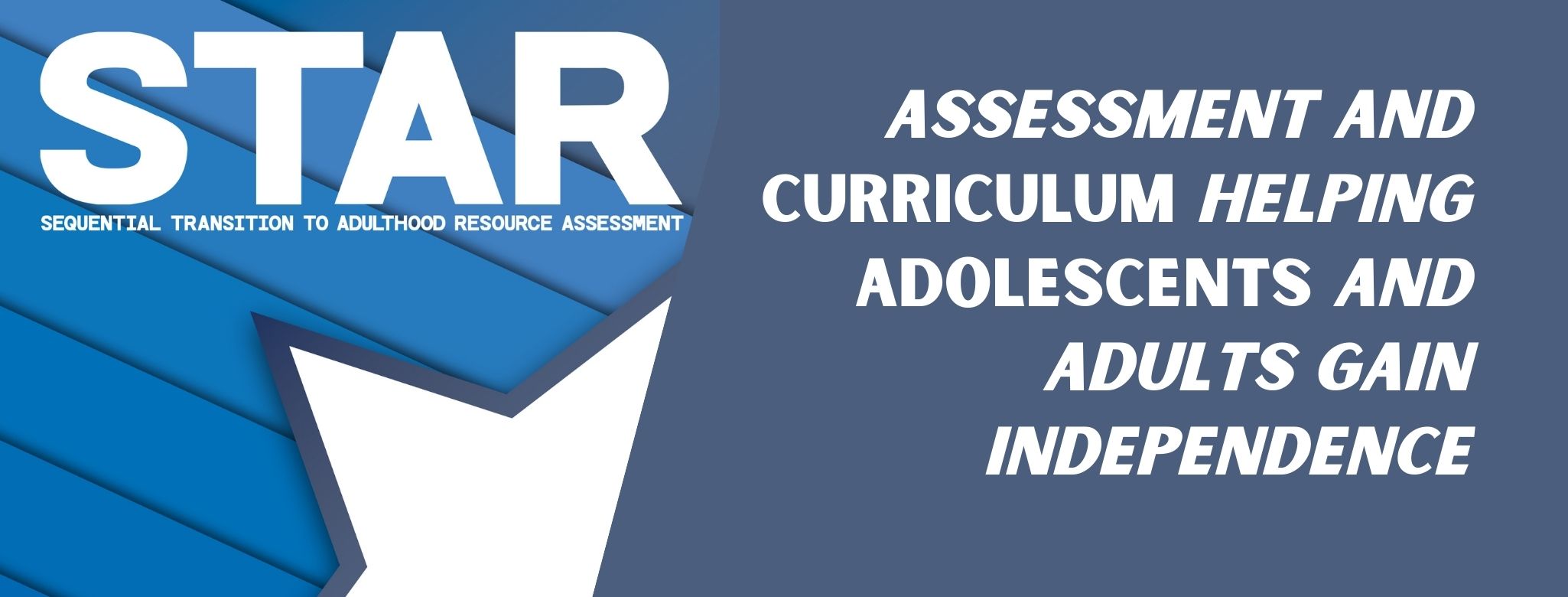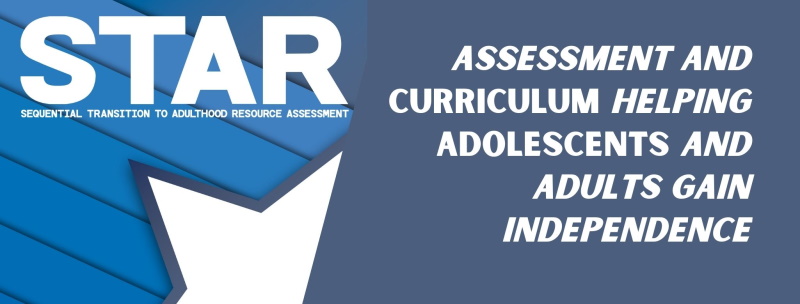



Adults with disabilities have a lot of potential to achieve amazing things! The lack of resources sometimes prevents people from achieving their full potential. Caretaking often falls to parents or to state funding. The emotional and financial cost of this can be great to everyone involved. The STAR assessment targets skills based on what the research says about what specific skills have the largest impact on the individual and their caretakers. The goal is to reduce the most amount of pain and gain access to the most amount of reinforcement. Review below some of the articles we used to design the assessment to have the largest impact possible.
Bulger, M. W., Wandersman, A., & Goldman, C. R. (1993). Burdens and gratifications of caregiving: Appraisal of parental care of adults with schizophrenia. American Journal of Orthopsychiatry, 63(2), 255-265.
CDC (2015) Disability and health healthcare cost data. Retrieved on March 27, 2021 from https://www.cdc.gov/ncbddd/disabilityandhealth/data-highlights.html
Deming, D. J. (2017). The growing importance of social skills in the labor market. The Quarterly Journal of Economics, 132(4), 1593-1640.
Greenberg, J. S., Seltzer, M. M., & Greenley, J. R. (1993). Aging parents of adults with disabilities: The gratifications and frustrations of later-life caregiving. The gerontologist, 33(4), 542-550.
Greenlee, J. L., Mosley, A. S., Shui, A. M., Veenstra-VanderWeele, J., & Gotham, K. O. (2016). Medical and behavioral correlates of depression history in children and adolescents with autism spectrum disorder. Pediatrics, 137(Supplement 2), S105-S114.
Gresham, F. M., Sugai, G., & Horner, R. H. (2001). Interpreting outcomes of social skills training for students with high-incidence disabilities. Exceptional children, 67(3), 331-344.
Hillier, A. J., Fish, T., Siegel, J. H., & Beversdorf, D. Q. (2011). Social and vocational skills training reduces self-reported anxiety and depression among young adults on the autism spectrum. Journal of Developmental and Physical Disabilities, 23(3), 267-276.
Jordan, K. A., Gagnon, R. J., Anderson, D. M., & Pilcher, J. J. (2018). Enhancing the college student experience: Outcomes of a leisure education program. Journal of Experiential Education, 41(1), 90-106
Montgomery, J. M., Schwean, V. L., Burt, J. A. G., Dyke, D. I., Thorne, K. J., Hindes, Y. L., ... & Kohut, C. S. (2008). Emotional intelligence and resiliency in young adults with Asperger's disorder: Challenges and opportunities. Canadian Journal of School Psychology, 23(1), 70-93.
Namkung, E. H., Song, J., Greenberg, J. S., Mailick, M. R., & Floyd, F. J. (2015). The relative risk of divorce in parents of children with developmental disabilities: impacts of lifelong parenting. American journal on intellectual and developmental disabilities, 120(6), 514-526.
Patterson, I. (2001). Serious leisure as a positive contributor to social inclusion for people with intellectual disabilities. World Leisure Journal, 43(3), 16-24.
Spengler, M., Brunner, M., Damian, R. I., Lüdtke, O., Martin, R., & Roberts, B. W. (2015). Student characteristics and behaviors at age 12 predict occupational success 40 years later over and above childhood IQ and parental socioeconomic status. Developmental psychology, 51(9), 1329.
Sias, P. M., & Bartoo, H. (2007). Friendship, social support, and health. In Low-cost approaches to promote physical and mental health (pp. 455-472). Springer, New York, NY.
The STAR assessment includes program sheets to help develop each goal. The strategies are based in scientific research that has been proven to be effective with this age group and population. Review below some of the articles that support the implementation methods.
Bennett, K. D., & Dukes, C. (2014). A systematic review of teaching daily living skills to adolescents and adults with autism spectrum disorder. Review Journal of Autism and Developmental Disorders, 1(1), 2-10.
Bishop-Fitzpatrick, L., Minshew, N. J., & Eack, S. M. (2013). A systematic review of psychosocial interventions for adults with autism spectrum disorders. Journal of Autism and Developmental Disorders, 43(3), 687-694.
Cannella-Malone, H. I., & Schaefer, J. M. (2017). A review of research on teaching people with significant disabilities vocational skills. Career Development and Transition for Exceptional Individuals, 40(2), 67-78.
Delhom, I., Satorres, E., & Meléndez, J. C. (2020). Can we improve emotional skills in older adults? Emotional intelligence, life satisfaction, and resilience. Psychosocial Intervention, 29(3), 133-139.
Esbensen, A. J., Seltzer, M. M., Lam, K. S., & Bodfish, J. W. (2009). Age-related differences in restricted repetitive behaviors in autism spectrum disorders. Journal of autism and developmental disorders, 39(1), 57-66.
Gutman, S. A., Raphael-Greenfield, E., & Rao, A. K. (2012). Effect of a motor-based role-play intervention on the social behaviors of adolescents with high-functioning autism: Multiple-baseline single-subject design. American Journal of Occupational Therapy, 66(5), 529-537. doi:http://dx.doi.org.portal.lib.fit.edu/10.5014/ajot.2012.003756
Horn, J. A., Miltenberger, R. G., Weil, T., Mowery, J., Conn, M., & Sams, L. (2008). Teaching laundry skills to individuals with developmental disabilities using video prompting. International Journal of Behavioral Consultation and Therapy, 4(3), 279-286. doi:http://dx.doi.org.portal.lib.fit.edu/10.1037/h0100857
King, K., & Palmer, R. (2010). Planning for technical and vocational skills development. Paris: UNESCO, International Institute for Educational Planning.
Laugeson, E. A., & Ellingsen, R. (2014). Social skills training for adolescents and adults with autism spectrum disorder. In Adolescents and adults with autism spectrum disorders (pp. 61-85). Springer, New York, NY.
Liu, K. P., Wong, D., Chung, A. C., Kwok, N., Lam, M. K., Yuen, C., ... & Kwan, A. (2013). Effectiveness of a Workplace Training Programme in Improving Social, Communication and Emotional Skills for Adults with Autism and Intellectual Disability in Hong Kong-A Pilot Study. Occupational Therapy International, 20(4).
Mason, L., Sawchak, A., Curtis, S., Andrews, A., Arriaga, A., & Pena, H. (2018). A Comparison of Outcomes From Criterion-Referenced and Experimental Evaluations of Verbal Behavior. American Psychological Association, 23(2), 118-129.
Matson, J. L., Hattier, M. A., & Belva, B. (2012). Treating adaptive living skills of persons with autism using applied behavior analysis: A review. Research in Autism Spectrum Disorders, 6(1), 271-276.
Orellano, E., Colón, W. I., & Arbesman, M. (2012). Effect of occupation-and activity-based interventions on instrumental activities of daily living performance among community-dwelling older adults: a systematic review. American Journal of Occupational Therapy, 66(3), 292-300.
doi:http://dx.doi.org.portal.lib.fit.edu/10.1080/01608060802660157
Rose, H. M. S., & Ludwig, T. D. (2009). Swimming pool hygiene: Self-monitoring, task clarification, and performance feedback increase lifeguard cleaning behaviors. Journal of Organizational Behavior Management, 29(1), 69-79.
Spriggs, A. D., Gast, D. L., & Knight, V. F. (2016). Video modeling and observational learning to teach gaming access to students with ASD. Journal of Autism and Developmental Disorders, 46(9), 2845-2858. doi:http://dx.doi.org.portal.lib.fit.edu/10.1007/s10803-016-2824-3
Weiss, M. J. (2001). Expanding aba intervention in intensive programs for children with autism: The inclusion of natural environment training and fluency based instruction. The Behavior Analyst Today, 2(3), 182-186. doi:http://dx.doi.org.portal.lib.fit.edu/10.1007/s10803-016-2824-3